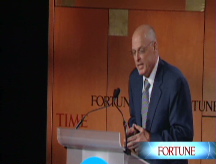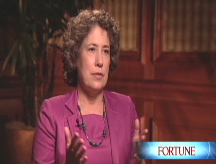Credit markets ease slightly
Government debt prices edge slightly higher and bank-to-bank lending rates decline ahead of expected rate cuts by European central banks.
NEW YORK (CNNMoney.com) -- The credit markets showed slightly improved confidence Wednesday, as lending rates fell ahead of expected interest rate cuts by Europe's central banks.
The 3-month Libor rate eased Wednesday to 2.20% from 2.21% Tuesday, according to Bloomberg.com. The overnight Libor fell to 0.88% from 1% Tuesday.
Libor, the London Interbank Offered Rate, is a daily average of what 16 different banks charge other banks to lend money in London and is used to calculate adjustable-rate mortgages. More than $350 trillion in assets are tied to Libor.
One reason the overnight Libor rate fell was in response to banks' and institutions' increased borrowing demands at the end of the month, according to Kim Rupert, fixed-income analyst at Action Economics.
"The overnight rate has fallen now that we have passed the turn into the new month of December," said Rupert.
Government debt prices ticked lower, but Treasury prices remained at very elevated levels with yields near record lows. Investors have shied away from the sharp movements in the stock market and prefer to keep their funds in the safe haven of Treasurys, even if it means sacrificing profit.
European banks to slash rates: The U.S. central bank has slashed key interest rates aggressively, but central banks in Europe have been more cautious to cut interest rates.
However, the European Central Bank and the Bank of England are expected to lower their key lending rates when they make monetary policy announcements later in the week.
One analyst said that rate-cut expectations are very widely held. "The market has pretty much priced in rates cut from both," said Rupert. "The question is how big and what will their policy statements say, which will give some hint as what to expect for the future."
Bank confidence: Since the start of the credit crisis, governments across the globe have worked to juice the economy by pumping the system with liquidity. The efforts have worked to bring Libor rates down significantly. The 3-month Libor peaked at 4.82% and the overnight Libor hit a record high of 6.88%.
However, banks have still been hesitant to lend to each other because banks have become skeptical of the health of another bank's balance sheet.
Analysts fear that when Goldman Sachs (GS, Fortune 500) and Morgan Stanley (MS, Fortune 500) report their fourth quarter results later this month that even these Wall Street behemoths will show signs of weakness.
The level of trust between banks has declined significantly in the wake of the credit crisis, causing the institutions to hoard cash instead of lending. "I don't think banks are going to have the same confidence levels that they once did," said Rupert.
"It is a whole new ball game now, and we are going to have to figure out how to price this confidence between banks and institutions," she added.
Credit market gauges: Meanwhile, two market gauges were mostly unchanged Wednesday.
The "TED spread" broadened to 2.17 percentage points from 2.14 late Tuesday. The TED spread measures the difference between the 3-month Libor and the 3-month Treasury bill, and is a key indicator of risk. The higher the spread, the more unwilling investors are to take risks.
Another indicator, the Libor-OIS spread, held steady at 1.82 percentage points from late Tuesday. The Libor-OIS spread measures how much cash is available for lending between banks, and is used for determining lending rates. The bigger the spread, the less cash is available for lending.
Treasurys: Government debt prices were higher Wednesday, but only very slightly, and yields fell near the record low levels set in recent sessions.
Bond prices and yields move in opposite directions. Treasurys are perceived as one of the safest places for investors to keep their assets in times of economic uncertainty and higher prices signal a flight to safety.
"The market is just off of its record highs," said Rupert. "Treasurys are still the safest investment around and it confirms the fear in the market that people would be willing to give the government their money for 10 years at such low rates."
The yield on the benchmark 10-year note rose 2/32 to 109-13/32 and its yield fell to 2.67% from 2.68%. Last week, the 10-year yield fell below 3% for the first time since the note was first issued in 1962.
The 30-year bond rose 1/32 to 125-10/32 and its yield slipped to an all-time low of 3.17%.
The 2-year note was unchanged at 100-23/32 and its yield held at 0.9%.
The yield on the 3-month note dipped to 0.02% from 0.04% late Tuesday. The bill is closely watched as an indicator of investor confidence. Investors and money-market funds shuffle funds in and out of the 3-month bill frequently, as they assess risk in the rest of the marketplace. A higher yield indicates that investors are slightly more optimistic.
The government has been selling an increased amount of government debt to finance the pricey rescue of the financial system, but the increased supply of Treasurys has not prevented government bond yields from falling to record lows as investors have made safety a priority. ![]()





